
The iconic American motorcycle brand and the American watchmaker have collaborated in turning a Harley-Davidson FXSTB Softail Nightrain into a creative mash-up that features a Bell & Ross BR 01 Carbon watch installed in the handcrafted center console using a machined section of aluminum.
The special edition bike, which was overseen by Harley tuner extraordinaire, Shaw, is a one-off edition that has been christened as the “Nascafe Racer”. In building the bike, Shaw stripped the Harley back to its bare ‘n bones state before implanting the B&R watch into the center console. After doing so, the tuner custom painted the bike by using a combination of anodized blue, carbon, and a matte black custom paint finish to complete the stylish and expensive makeover.
While we never would have thought that Bell & Ross and Harley-Davidson would go hand-in-hand, given the segments to which their clientele belongs, we do applaud both American brands for the collaboration, if only to show that a hardcore-performance bike like Harley-Davidson and a luxury American timepiece like Bell & Ross can strike a partnership and create a one-of-a-kind ride.
Popular Posts
-
Valentino Rossi, 2009 MotoGP World Champion Sepang - Valentino Rossi is sure to become a world champion MotoGP season one series remaining. ...
-
Kawasaki Ninja 650R Bike Kawasaki Ninja 650R Bike Kawasaki Ninja 650R Bike Kawasaki Ninja 650R Bike Kawasaki Ninja 650R Bike
-
Launch: 2011 Triumph Speed Triple Triumph has a lot to thank the Speed Triple for, as it’s been a real flag bearer f...
-
2011 Suzuki GSX-R 600/750 Reliable source close to Suzuki have leaked an artist rendering of what the rumoured all-new 2011 GSX-R 600 and p...
-
The New Kawasaki Ninja ZX-10R Race Bike has been eagerly anticipated by everyone involved in the Superbike Racing project for a while now ...
Labels
- 2008 BMW Motorcycles (1)
- 2009 BMW Motorcycles (1)
- 2009 Ducati Motorcycles (2)
- 2009 Yamaha Motorcycles (4)
- 2010 Aprilia Motorcycles (3)
- 2010 BMW Motorcycles (3)
- 2010 British Superbike Championship season (1)
- 2010 British Superbike Championship season --Calendar And Entry List (1)
- 2010 Ducati Motorcycles (7)
- 2010 Harley Davidson (3)
- 2010 Honda Motorcycles (13)
- 2010 Kawasaki Motorcycles (5)
- 2010 Suzuki Motorcycles (7)
- 2010 Triumph Motorcycles (1)
- 2010 Yamaha Motorcycles (13)
- Agusta (3)
- Agusta Bikes (7)
- aksesoris (1)
- Aprilia (21)
- Aprilia Bikes (12)
- Aprilia Motorcycle (14)
- Aprilia Motorcycles (3)
- APRILLIA (5)
- ATV's (2)
- Audi Bikes (2)
- AWARD EXPO (1)
- Bajaj Motorcycle (3)
- Benelli (2)
- Benelli Bikes (4)
- Benelli Motorcycle (4)
- Best Modification (29)
- Big Dog Bikes (1)
- Bikes For Sale (1)
- Bikes Review And News (1)
- Bimota (2)
- Bimota Bikes (6)
- Bimota Motorcycle (5)
- BMW (36)
- BMW Bikes (13)
- BMW Motorcycles (6)
- Buell (9)
- Buell Bikes (7)
- Buell MotorCycle (2)
- Cagiva (1)
- Cagiva Bikes (8)
- Cagiva Motorcycle (1)
- Can -Am Spyder Bikes (6)
- Can- Am (2)
- Can-Am (2)
- Concept Motorcycle (3)
- Custom Bike-Motorcycle (7)
- Dani Pedrosa Bikes (2)
- Design Motorcycle (4)
- Dirt Rider (1)
- Dodge Bikes (1)
- DUCATI (35)
- Ducati Bikes (5)
- Ducati Motorcycle (25)
- Ducati Motorcycles (11)
- Fisher Motor Sport (1)
- Geneva Show (1)
- Harley Davidson (18)
- Harley Davidson Bikes (6)
- Harley Davidson Motorcycles (3)
- Harley-Davidson (25)
- Honda (57)
- Honda Bikes (26)
- Honda motorcycle (20)
- Honda Motorcycles (25)
- Hot Bikes (2)
- Husaberg Motorcycle (1)
- Husqvarna (1)
- Husqvarna Bikes (5)
- Hyosung (1)
- Hyosung Bikes (6)
- Indian (4)
- Kawasaki (36)
- Kawasaki ATVs (1)
- Kawasaki Bikes (12)
- Kawasaki Motorcycles (23)
- KTM (15)
- KTM Bikes (6)
- KTM Sports (9)
- Kymco (2)
- Kymco Bikes (5)
- Macchia Nera (1)
- Mavizen (1)
- Modified Motorcycles (1)
- Moto Guzzi (1)
- MOTO GUZZI (3)
- Moto Guzzi Bikes (6)
- Motocross Bikes (3)
- MOTOGP (4)
- MotoGP Sport Rider (1)
- Motorcycle Insurance (2)
- MOTORCYCLE MODIFICATION (3)
- Motorcycle Race (1)
- motorcycle show (16)
- Motorcycles News (19)
- MV Agusta (3)
- MV Agusta Sportbike (5)
- Ninja MotorCycles (5)
- Norton (2)
- Norton Bikes (4)
- Old Bikes (1)
- Peugeot (1)
- Polaris (1)
- Privacy Policy (1)
- Racing Bikes (1)
- Ridley (1)
- Roehr (3)
- Roehr Bikes (5)
- Roehr Sport MotorCycle (2)
- Sachs (1)
- Scooters (4)
- Sports Bike BMW (13)
- Super Bikes (4)
- SUPERBIKE (1)
- Suzuki (33)
- Suzuki Bikes (6)
- Suzuki Motorcycles (32)
- Top Bikes (4)
- Touring Bikes (1)
- Travertson show (2)
- Triumph (12)
- Triumph MotorCycles (8)
- Vectrix (2)
- Victory (5)
- Victory Kingpin (1)
- Victory Oto-mania (5)
- Video Motorcycles (3)
- Vulcan Motorcycle (1)
- Vyrus (1)
- Yamaha (67)
- Yamaha ATVs (1)
- Yamaha Bikes (15)
- Yamaha Launch (58)
- Yamaha Motorcycles (23)
Harley-Davidson-Bell & Ross Nascafe Racer
Labels: Harley Davidson
Bimota Modified Bikes

2010-Bimota-DB7R-Diavolo-Rosso-Sport-Bike


Labels: Modified Motorcycles
BMW K1600GT MotorBikes
 BMW K1600GT MotorBike
BMW K1600GT MotorBike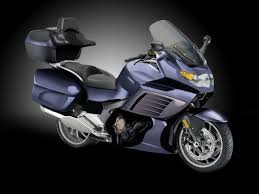 BMW K1600GT MotorBike
BMW K1600GT MotorBike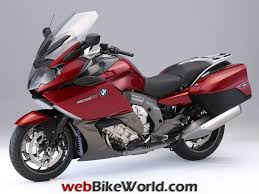 BMW K1600GT MotorBike
BMW K1600GT MotorBike BMW K1600GT MotorBike
BMW K1600GT MotorBike BMW K1600GT MotorBike
BMW K1600GT MotorBikeLabels: BMW Bikes
Roehr 1130 Superbike
Review
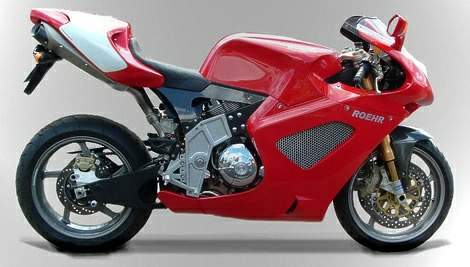
Technical Specifications:
Engine:
Type 2 cylinder, liquid cooled, DOHC, Counterbalanced, 60deg, V-twin
Displacement 1130cc
Bore X Stroke 100mm X 72mm
Compression ratio 11.3 / 1
Transmission 5 speed
Clutch Wet, multi-plate, hydraulic actuation
HP/Torque 120hp / 75lb/ft
Final drive Chain
Chassis:
Type Steel/aluminum composite beam frame, 4130 steel/ 7075 aluminum
Wheelbase 56 inches (1422mm)
Rake/trail 23.5deg. / 97mm
Seat height 31.5 inches
Dry weight 425lbs. (193kg)
Front suspension Ohlins 43mm fully adjustable upside-down fork with TiN
Rear suspension Ohlins fully adjustable linkless monoshock
Front Brakes 2 x 330mm semi-floating discs, radially mounted Brembo monobloc
4 piston calipers. (Production version)
Rear brake 245mm single disc, with 2 piston Brembo caliper
Frt. Wheel/tire 3.5 x 17 forged aluminum 10 spoke Marchesini, 120/70 ZR17 tire
(Production version)
Rear wheel/tire 6.0 x 17 forged aluminum 10 spoke Marchesini, 190/55 ZR17 tire
(Production version)
Fuel tank capacity 3.6 US gallons
Labels: Roehr Bikes
Kawasaki Versys
Kawasaki has introduced a brand new multi purpose motorcycle designed for all sorts of different riding styles and needs, the 2008 Versys. It's a 649cc 8 valve parallel twin that looks pretty good.
Kawasaki press release follows:
The new 2008 Kawasaki Versys is a machine which occupies a hard to define sweet spot in the motorcycling universe. Is it a practical commuter? Long-legged urban assault vehicle? Sportbike? Light Tourer?
The answer on all counts is a resounding Yes! This isn’t a niche specialist but rather a jack-of-all-trades with user-friendly versatility as one of its many charms.
The 649cc parallel twin and the neutral handling and light steering chassis of the Ninja 650R sportbike made the perfect starting point for this comfortable gridlock commando. A swoopy gull-wing swingarm, long-travel inverted 41mm fork, six-spoke superbike-inspired wheels, adjustable-height windscreen and a comfortable cockpit were combined to create a motorcycle that just begs to be ridden wherever the pavement might lead.

The compact liquid-cooled, fuel-injected, DOHC, 8-valve, 649cc parallel twin engine was modified for the Versys motorcycle so it delivers smooth power that’s well-suited for off-the-line acceleration and flexible torque in the cut-n-thrust of a rider’s morning commute. This engine’s overall characteristics are entertaining for even the most advanced riders, yet predictable enough to inspire confidence in less-experienced motorcyclists.
Full press release and more photos below:
Its suspension offers the next level in sophistication: an advanced Showa rear shock featuring a free piston and two-stage damping valves for progressive compression damping which firms significantly as the shock moves through its stroke. This allows a longer wheel travel with a feel that is initially soft like a dual sport, but firms to near sportbike levels as suspension loads escalate. Of course, this advanced shock is fully-adjustable and connected to a beautiful aluminum gull-wing swingarm that is longer than average, thanks to a short/compact engine and chassis.
Up front, the Versys suspension continues the high-tech approach with a fully-adjustable 41mm tapered-tube inverted fork that combines the best of off-road and sportbike suspension action for a stiffness balance that is a perfect compliment to the chassis settings. In addition to a more-comfortable ride, the long-travel suspension’s soft-stroke allows easy control of the chassis’ running angle by shifting the rider’s weight.
Complimenting the able suspension is the carefully designed cockpit that features a two-piece seat constructed to provide optimum comfort to both the rider and passenger. An easy-to-read and informative instrument panel allows riders to quickly scan the gauges and get their eyes back on the road. Capping off the comfort list is an adjustable windscreen that can be raised or lowered to three positions in 20mm increments.
Engine
649cc parallel twin-cylinder, DOHC engine is the most compact in its category.
The engine is considerably smaller than that of the Ninja 500 and helps reduce the dimension of the entire motorcycle
Tuned to deliver smooth, responsive power in the low-to mid-rpm range with exceptional roll-on response ideal for negotiating city traffic
Triangular crank and transmission shaft layout makes it short front to back, a semi-dry sump oil system reduces overall engine height, and the narrow pitch of the chrome composite plated aluminum cylinders helps reduce engine width
Muffler with 3-way catalyzer and bullet-tip opening is mounted below the engine to help lower the center of gravity and aid weight centralization
180-degree crankshaft plus balancer shaft for extremely smooth engine operation
Oil jets on the connecting rod big ends spray oil on the undersides of the pistons to aid cooling
Liquid Cooling
Fewer external hoses because the coolant is routed through the engine cases
Digital Fuel Injection (DFI)
Utilizes 38mm Keihin throttle bodies with ECU controlled sub throttle valves for optimum performance and rideability
The sub throttles, located behind the main throttle valves, permit the DFI system a more precise throttle response, similar to a constant velocity carburetor
Automatic fast idle system makes starting and warm-up easy
Digital Capacitor Discharge Ignition (CDI) System
Microprocessor controlled timing never requires adjustment and is ultra responsive to engine needs
Spark plug mounted “stick” ignition coils are compact and help reduce weight
Six-Speed Transmission
Cassette style transmission means the shafts and shift drum are in a compact layout that is easily removed as a single unit from the case for easier maintenance
Trellis Frame
High tensile steel trellis frame is small and light
Designed using 3-dimensional computer analysis to achieve the optimum stiffness balance for better handling
Narrow at the knees and feet for increased rider comfort and control
Single shock Rear Suspension
Aluminum gull-wing swingarm and offset, laydown single rear shock complement the frame design to create an integrated line flowing from the steering head to the rear hub
Short, compact frame and engine design allows the swingarm to be longer, which helps improve overall handling
Showa shock has adjustable preload and rebound damping and uses a free piston and two-stage damping valves for smooth action during initial compression that becomes much firmer near the end of the stroke for a more planted feel
Long-Travel Fork
41mm Inverted fork with stiff springs combines the best of off-road and sportbike-type suspension for excellent performance over a wide range of conditions
Tapered, relatively short outer tubes help provide the ideal stiffness balance to compliment chassis settings
Fork height, preload and rebound damping can all be adjusted to fine-tune the suspension to specific conditions or riding style
Triple Petal Design Brake Discs
Petal design rotors offer improved cooling and warp resistance
Same rotor design as found on the Ninja ZX-6R and ZX-10R supersport machines
Six-spoke wheels
Also found on the Ninja ZX-6R and ZX-10R; the six-spoke design requires much less material between spokes so that the rim thickness is thinner and overall wheel weight is reduced
Comfortable Cockpit
Each part of the two-piece seat was designed with a different thickness and firmness of foam to optimize comfort for both rider and passenger
Passenger seat and grab bars were designed to provide a natural seating position for added comfort
Easy-to-read instrument panel has a large analog tachometer and digital readout for the speedometer, fuel gauge, odometer, dual trip meters and clock. White LED backlighting provides increased visibility at night
Adjustable Windscreen
Three different settings, each 20mm apart, allows riders to adjust windscreen height to suit their preferences
Specifications:
Engine: Four-stroke, liquid cooled, DOHC, four-valve per cylinder, parallel twin
Displacement: 649cc
Bore x stroke: 83.0 x 60.0mm
Compression ratio: 10.6:1
Maximum torque: 44.9 lb/ft @6,800 rpm
Cooling: Liquid
Fuel injection: Digital fuel injection with two 38mm Keihin throttle bodies
Ignition: Digital CDI
Transmission: Six-speed
Final drive: O-Ring chain
Frame: Semi-double cradle, high-tensile steel
Rake / trail: 25 degrees / 4.3 in.
Wheelbase: 55.7 in.
Front suspension / wheel travel: 41mm hydraulic telescopic fork with adjustable rebound and preload / 5.9 in.
Rear suspension / wheel travel: Single offset laydown shock with adjustable rebound and spring preload / 5.7 in.
Front tire: 120/70x17
Rear tire: 160/60x17
Front brake: Dual 300mm petal discs with two-piston caliper
Rear brake: Single 220mm petal disc with single-piston caliper
Overall length: 83.7 in.
Overall width: 33.1 in.
Overall height: 51.8 in.
Seat height: 33.1 in.
Dry weight: 399 lbs.
Fuel capacity: 5.0 gal.
Color: Passion Red
MSRP: $6,899
Warranty: 12 months
Labels: Kawasaki Bikes
German motorcycle Grand Prix--History
The German motorcycle Grand Prix, first held in 1925, is since 1952 part of the Grand Prix motorcycle racing World Championship.

History
The first two Großer Preis von Deutschland races were held at Berlin's AVUS before moving to the new the purpose-built Nürburgring which was used in its full 28 km configuration. No GP was held in 1932, in 1933 the AVUS was given another try, and since 1934, public roads near and through Hohenstein-Ernstthal in Saxony were in use, initially without the name Sachsenring which had been used elsewhere. It was adopted in 1937.
After the war, in 1949, two German states were founded, and the FIM introduced a motorcycle World Championship in which neither Germans nor German race tracks could participate due to still being banned. In the (Western) Federal Republic of Germany, a strong motorcycle industry (NSU, DKW etc.) emerged in the early 1950s, as cars were not yet affordable. With the Sachsenring being now in the (Eastern) German Democratic Republic (GDR), a new venue had to be selected. The Nürburgring was damaged and due to its length not very suitable. The Solitudering near Stuttgart had a challenging layout and due to proximity of a major city, the crowds were large, but the narrow roads had to be widened. In 1953, the Schottenring near Fulda was chosen, but due to lack of safety, it was partially boycotted, and only the small classes races had WC status. Attendance at the Nürburgring, which was by now used in its 22.8 km Nordschleife configuration, was disappointing. Former DKW and NSU factory rider and world record setter Wilhelm Herz promoted the Hockenheimring successfully. Thus, with Hockenheim (in odd-numbered years) and Solitude, two tracks in the southwestern state of Baden-Württemberg shared the German GP until the mid-1960s, when the Solitude was abandoned and replaced by the Nürburgring. There, the lesser known 7.7 km Südschleife was used twice, as in the Eifelrennen races which often attracted international entrants, but that part of the track was not rebuilt in 1970/71; thus in the even years from 1970 to 1980, the famous Nordschleife was used.
In that time, also the "Grand Prix of the GDR", held on the Sachsenring, was part of the WC from 1961 to 1972. It is referred to as East German GP, EGER for short on the Moto GP website. During that period the German GP was also referred to as West German GP (WGER), even though its name never changed.

The popularity of motorcycles sharply fell in late 1950s Germany, as now everyone aspired to get an automobile. Only BMW survived, dominating side car racing. The East German brand MZ had made groundbreaking progress in two stroke technology, but due to defecting personnel and other problems, they fell behind in the late 1960s. After West German Dieter Braun won the East German race on the Sachsenring in 1971, the crowd sung the (West) German anthem, the Deutschlandlied. To prevent further "demonstrations", the East German politicians, otherwise eager to gain international recognition, sacrificed the event's World Championship status, limiting entry of riders from Western states from 1972 onwards. With mainly riders from other Eastern bloc socialist states taking part, it was still called Großer Preis der DDR until 1977, when it was renamed Großer Preis des ADMV der DDR after the motorsports governing body.
In 1974, the event on the improved Nürburgring Nordschleife was boycotted by championship contenders as the track had not been fitted with enough straw bales. Traditionally, the Eifelrennen hosted motorcycle and automobile racing on the same weekend. Safety demands became problematic, as drivers asked for armco and catch fences, while rider safety requires unobstructed surroundings, with walls of straw bales in front of obstacles. With Agostini and others holding out, German amateur riders took all wins. The Eifelrennen in spring became an automobile event, and the GP became a separate event in August.
A few years later, in 1980, the last German GP was held on the Nordschleife, with the new GP track taking over in 1984.
The additional 1986 Baden-Württemberg Grand Prix (at Hockenheim) counted towards the WC only for 80cc and 125cc classes.
In 1998, after having become rather unpopular first at Hockenheim and then at Nürburgring due to the style of the promoters, the German motorcycle Grand Prix moved to new promoters, and to the shortened purpose-built Sachsenring where it became a sell-out event since.
Labels: Top Bikes
Suzuki Hayabusa

Suzuki Hayabusa
The Suzuki Hayabusa (or GSX1300R) is a Sport bike motorcycle made by Suzuki since 1999. It immediately won acclaim as the world's fastest production motorcycle, with a top speed of 188–194 miles per hour (303–312 km/h).
Hayabusa Japanese for "peregrine falcon", a bird that often serves as a metaphor for speed due to its vertical hunting dive, or stoop, speed of 180 to 240 miles per hour (290 to 390 km/h), the fastest of any bird. In particular, the choice of name was made because the peregrine falcon preys on blackbirds which reflected the intent of the original Hayabusa to unseat the Honda CBR 1100 XX Super Blackbird as the world's fastest production motorcycle.Eventually, the Hayabusa managed to surpass the Super Blackbird by at least a full 10 miles per hour (16 km/h).
In 2000, fears of a European regulatory backlash or import ban led to an informal agreement between the Japanese and European manufacturers togovern the top speed of their motorcycles at an arbitrary limit.
The media-reported value for the speed agreement in miles per hour was consistently 186 mph, while in kilometers per hour it varied from 299 to 303 km/h, which is typical given unit Conversion rounding errors. This figure may also be affected by a number of external factors,
The conditions under which this limitation was adopted led to the 1999–2000 Hayabusa's title to remain, at least technically, unassailable, since no subsequent model could go faster without being tampered with.
of 2000 fell 4 mph (6 km/h) short of claiming the title, the Hayabusa secured its place as the fastest standard production bike of the 20th century.
Besides its speed, the Hayabusa has been lauded by many reviewers for its all-around performance, in that it does not drastically compromise other qualities like handling, comfort, reliability, noise, fuel economy or price in pursuit of a single functionJay Koblenz of Motorcycle Consumer News commented, "If you think the ability of a motorcycle to approach 190 mph or reach the quarter-mile in under 10 seconds is at best frivolous and at worst offensive, this still remains a motorcycle worthy of just consideration. The Hayabusa is Speed in all its glory. But Speed is not all the Hayabusa is.
 Suzuki Hayabusa
Suzuki Hayabusa Suzuki Hayabusa
Suzuki Hayabusa Suzuki Hayabusa
Suzuki HayabusaLabels: Suzuki Bikes
2011 The Ducati Diavel Carbon

Tomorrow Asphalt & Rubber must make the trek down from perfect Northern California, to SoCal and the pits of Los Angeles, where dreams go to die. As we descend down through the lower rings of Dante’s ladder and into hell that is the perpetually sunny and warm Los Angeles, our final destination will in fact bring us face-to-face with The Devil himself. Riding the latest creation from Bologna, the American motorcycle press will get its first chance at the highly anticipated Ducati Diavel.


Since we’ll be bringing you live coverage from the event, and writing a few pieces on Ducati’s stab at the performance cruiser segment throughout the rest of the week, we thought it best to start with a primer on the motorcycle.
Labels: DUCATI
World Top Bikes

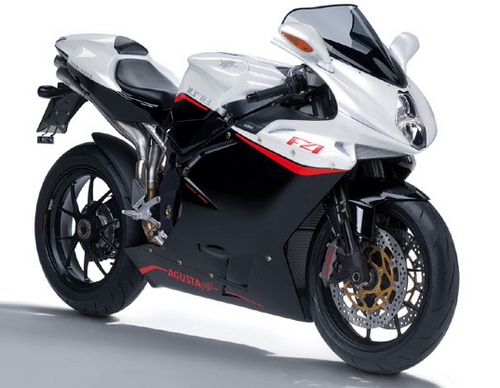
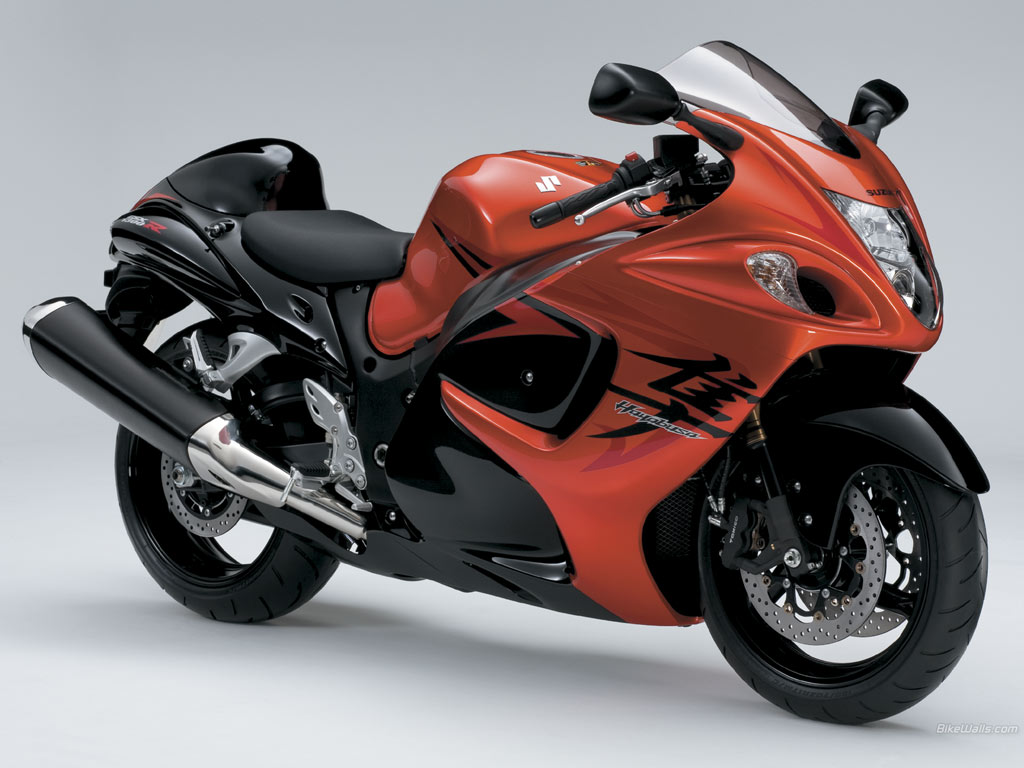
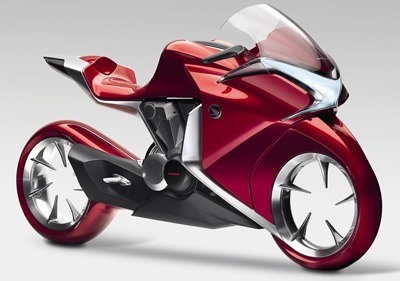



Labels: Top Bikes
Honda VFR 1200F DCT Best Motorcycle Sport 2011

Honda VFR 1200F Motorcycle Sport The New VFR1200F : Welcome to the Revolution. From CRF/Rs to CBRs to ATVs, Honda is legendary for its innovative, breakthrough engineering and design. And nowhere is this forward-thinking stamp more indelible than on the all-new 2010 VRF1200F, a literal showcase of technological advancement that, from its inception, had but one objective in mind: to create the most complete and perfect sport riding experience ever. From nose to tail, from ergos to engine size to exhaust placement to bodywork design, there’s other machine like it. Which, of course, is exactly what you’d expect from a Honda.
Honda VFR 1200F Motorcycle Sport Radical doesn’t begin to describe the all-new 2010 VFR1200F. After they took it for their inaugural spin Cycle World called it “revolutionary.” And while that certainly describes this incredible new machine, it doesn’t begin to do it justice. The list of innovative technology is endless: the layered, MotoGP-inspired bodywork that’s literally fused in seamless perfection for optimal aerodynamics. An all-new, super-compact Unicam® design 1237cc V4 engine, fueled by Honda’s first-ever Throttle By Wire system. Combined Braking with standard ABS. But perhaps most striking of all is the game-changing Honda Dual-Clutch automatic Transmission: Six speeds, two clutches, and your choice of changing gears with a pair of F1-style paddle shifters or letting the bike shift itself. It’s a feature that has completely blown away even the most cynical magazine test rider. And if you prefer, there’s also a second version of the VFR1200F equipped with a conventional six-speed gearbox and a slipper clutch.
Honda VFR 1200F Motorcycle Sport As if the incredible new VFR1200F weren’t trick enough in its standard, manual six-speed form, this standard-setting machine also comes equipped with one of the most advanced and Formula 1-esque features to ever grace a Honda motorcycle: DCT, a.k.a. Dual Clutch Transmission. Opt for push-button six-speed “paddle-style” shifting, or go totally automatic (yep, twist the throttle and the transmission will shift itself up and down through its gears). Better still, you can choose from two modes in Automatic: “D” for regular cruising, or “S” for a sportier pace.
Price VFR1200F DCT MSRP $17,499
Price VFR1200F MSRP $15,999
Specifications
ENGINE Honda VFR 1200F Motorcycle Sport
Engine Type 1237cc liquid-cooled 76 degrees V-4
Bore And Stroke 81mm x 60mm
Induction Programmed Fuel Injection (PGM-FI) with automatic enrichment circuit, 44mm throttle bodies and 12-hole injectors
Ignition Digital transistorized with electronic advance
Compression Ratio 12.0:1
Valve Train SOHC; four valves per cylinder
CHASSIS Honda VFR 1200F DCT Motorcycle Sport
Front Suspension 43mm cartridge fork with spring-preload adjustability; 4.7 inches travel
Rear Suspension Pro Arm single-side swingarm with Pro-Link single gas-charged shock with remote spring-preload adjustability and rebound-damping adjustability; 5.1 inches travel
Front Brake Dual full-floating 320mm discs with CBS six-piston calipers with ABS
Rear Brake Single 276mm disc with CBS two-piston caliper with ABS
Front Tires 120/70 ZR-17 radial
Rear Tires 190/55 ZR-17 radial
DIMENSION Honda VFR 1200F DCT Motorcycle Sport
Wheelbase 60.8 inches
Seat Height 32.1 inches
Curb Weight 591 pounds (Includes all standard equipment, required fluids and a full tank of fuel eady to ride)
Rake 25 degrees 30? (Caster Angle)
Trail 101.0mm (4.0 inches)
Fuel Capacity 4.9 gallons
OTHER Honda VFR 1200F DCT Motorcycle Sport
Emissions Meets current California Air Resources Board (CARB) and EPA standards.
Available Colors Candy Red
Model Id VFR1200F
Labels: Honda motorcycle
Buell Lightning Bikes Wallpapers
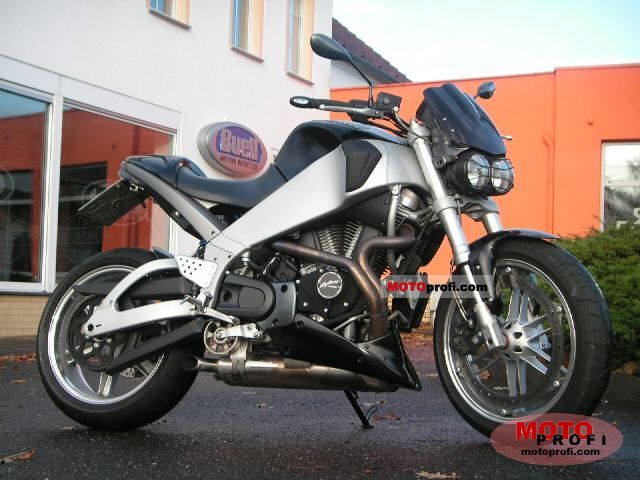


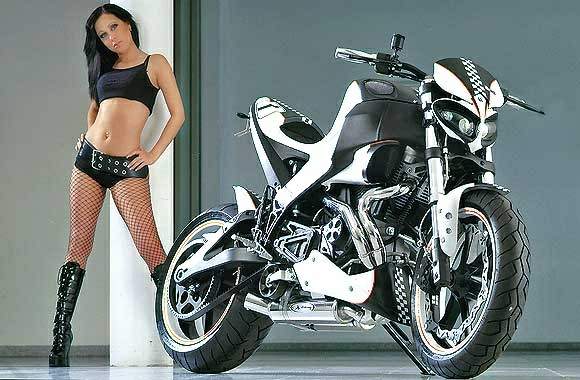
Labels: Buell Bikes
Cagiva Planet Pictures-Specifictions
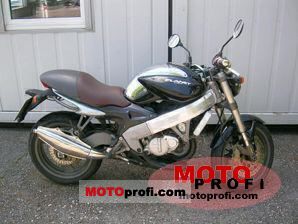
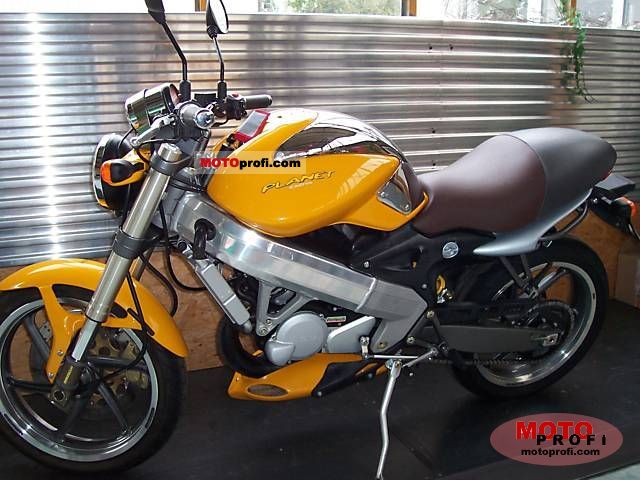



| TECHNICAL SPECIFICATION | |
|---|---|
| Model ID | |
| Manufacturer (Make) | Cagiva |
| Model Name | Planet 125 |
| Year | 1999 |
| Category(class) | Street Fighter |
| Engine | |
| Engine Capacity (Displacement) | 124.6 ccm (7.6 cubic inches) |
| Engine Type | 1 cylinder |
| Bore x Stroke | Ø56.0 mm x 50.6 mm (Ø2.2 inches x 1.99 inches) |
| Bore/Stroke Ratio | 1.11 |
| Stroke | 2 |
| Starter System | Electronic |
| Cooling System | Liquid |
| Powertrain | |
| Gearbox | 6 speed |
| Chassis/Suspension/Brakes | |
| Front Suspension Travel | 120 mm (4.72 inches) |
| Rear Suspension Travel | 140 mm (5.51 inches) |
| Front Brakes | Single disc |
| Front Brakes Diameter | Ø320 mm (Ø12.6 inches) |
| Rear Brakes | Single disc |
| Rear Brakes Diameter | Ø230 mm (Ø9.06 inches) |
| Front Tire | 110/70-17 |
| Rear Tire | 150/60-70 |
| Dimensions | |
| Seat Height | 780 mm (30.71 inches) |
| Wheelbase | 1395 mm (54.92 inches) |
| Curb Weight | 135 kg (298 lb) |
| Fuel Capacity | 12.5 litres (3.3 gallons) |
| Performance | |
| Max Power | 15.00 HP (10.9 kW) at 10400 RPM |
| Max Torque | 12.00 Nm (8.82 ft*lbs) at 8500 RPM |
| Power/Weight Ratio | 0.11 Hp/Kg |
| Top Speed | 114 km/h (71mph) |
| Acceleration (dart, speedup) time | |
| 0-100 km/h | 13.9 seconds |
| 0-60 mph | 13.2 seconds |
| - | |
| - | |
| Fuel Consumption | 5.8 litres/100km (40.53 mpg) |
Labels: Cagiva Bikes
Harley-Davidson FXS Blackline-2011

The Blackline balances allegiance with rebellion, discarding previous conventions of color and chrome for a Dark Custom look that’s honest, functional and attainable. Visual elements of the original bobber movement are combined with the raw, hand-hewn style embraced by today’s young builders. The Blackline throws new fuel on a fire that burns across generations, an unquenchable desire to ride.


The rear fender is bobbed high-and-tight over a slim, 144mm tire that emphasizes an authentic hardtail profile. The compact headlight and speedometer are tucked low into the wide, FX front end, and there’s just enough shine to make the black parts look blacker. Black-rimmed laced wheels complete a look that’s tough, tempered and undeniably Harley-Davidson.
The styling spotlight shines on a Big Twin engine dressed in black and silver, and on a fuel tank shaved smooth and low. Aboard the Blackline, the rider hugs the frame on the lowest two-up seat ever offered by Harley-Davidson, and reaches high for new Split Drag™ handlebars that bolt right to the top triple-clamp.


Labels: Harley Davidson











